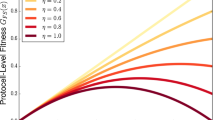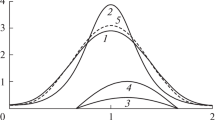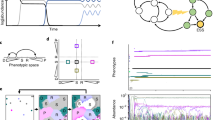Abstract
The compartmentalization of distinct templates in protocells and the exchange of templates between them (migration) are key elements of a modern scenario for prebiotic evolution. Here we use the diffusion approximation of population genetics to study analytically the steady-state properties of such a prebiotic scenario. The coexistence of distinct template types inside a protocell is achieved by a selective pressure at the protocell level (group selection) favoring protocells with a mixed template composition. In the degenerate case, where the templates have the same replication rate, we find that a vanishingly small migration rate suffices to eliminate the segregation effect of random drift and so to promote coexistence. In the nondegenerate case, a small migration rate greatly boosts coexistence as compared with the situation where there is no migration. However, increase of the migration rate beyond a critical value leads to the complete dominance of the more efficient template type (homogeneous regime). In this case, we find a continuous phase transition separating the homogeneous and the coexistence regimes, with the order parameter vanishing linearly with the distance to the transition point.





Similar content being viewed by others
References
Abramowitz, M., & Stegun, I. A. (1972). Handbook of mathematical functions with formulas, graphs, and mathematical tables. New York: Dover.
Alves, D., Campos, P. R. A., Silva, A. T. C., & Fontanari, J. F. (2001). Group selection models in prebiotic evolution. Phys. Rev. E, 63, 011911.
Aoki, K. (1982). A condition for group selection to prevail over counteracting individual selection. Evolution, 36, 832–842.
Bellomo, N., & Delitala, M. (2008). From the mathematical kinetic and stochastic game theory to modelling mutations, onset, progression and immune competition of cancer cells. Phys. Life Rev., 5, 183–206.
Bellouquid, A., de Angelis, E., & Knopoff, D. (2013). From the modeling of the immune hallmarks of cancer to a black swan in biology. Math. Models Methods Appl. Sci., 23, 949–978.
Blythe, R. A. (2007). The propagation of a cultural or biological trait by neutral genetic drift in a subdivided population. Theor. Popul. Biol., 71, 454–472.
Bresch, C., Niesert, U., & Harnasch, D. (1980). Hypercycles, parasites and packages. J. Theor. Biol., 85, 399–405.
Chalub, F. A. C. C., & Souza, M. O. (2009). A non-standard evolution problem arising in population genetics. Commun. Math. Sci., 7, 489–502.
Crow, J. F., & Kimura, M. (1970). An introduction to population genetics theory. New York: Harper & Row.
Czárán, T., & Szathmáry, E. (2000). Coexistence of replicators in prebiotic evolution. In U. Dieckmann, R. Law, & J. A. J. Metz (Eds.), The geometry of ecological interactions: simplifying spatial complexity (pp. 116–135). Cambridge: Cambridge University Press.
Donato, R., Peliti, L., & Serva, M. (1997). The selection of altruistic behaviour. Theory Biosci., 116, 309–320.
Doolittle, W. F. (2000). Uprooting the tree of life. Sci. Am., 282, 90–95.
Eigen, M. (1971). Self-organization of matter and the evolution of macromolecules. Naturwissenschaften, 58, 465–523.
Eigen, M., & Schuster, P. (1978). The hypercycle. A principle of natural self-organization. Part C: the realistic hypercycle. Naturwissenschaften, 65, 341–369.
Eigen, M., Gardiner, W. C. Jr., & Schuster, P. (1980). Hypercycles and compartments. J. Theor. Biol., 85, 407–411.
Engel, K.-J., & Nagel, R. (2000). One-parameter semigroups for linear evolution equations. New York: Springer.
Eshel, I. (1972). On the neighbor effect and the evolution of altruistic traits. Theor. Popul. Biol., 3, 258–277.
Fontanari, J. F., & Serva, M. (2013). Solvable model for template coexistence in protocells. Europhys. Lett., 101, 38006.
Fontanari, J. F., & Serva, M. (2014). Nonlinear group survival in Kimura’s model for the evolution of altruism. Math. Biosci., 249, 18–26.
Fontanari, J. F., Santos, M., & Szathmáry, E. (2006). Coexistence and error propagation in pre-biotic vesicle models: a group selection approach. J. Theor. Biol., 239, 247–256.
Kimura, M. (1983). Diffusion model of intergroup selection, with special reference to evolution of an altruistic character. Proc. Natl. Acad. Sci. USA, 80, 6317–6321.
Manrubia, S. C., & Briones, C. (2007). Modular evolution and increase of functional complexity in replicating RNA molecules. RNA, 13, 97–107.
Maynard Smith, J., & Szathmáry, E. (1995). The major transitions in evolution. Oxford: Freeman.
Mayr, E. (2001). The philosophical foundation of Darwinism. Proc. Am. Philos. Soc., 145, 488–495.
Mayr, E. (2002). What evolution is. New York: Basic Books.
Mayr, E. (2004). 80 years of watching the evolutionary scenery. Science, 305, 46–47.
Michod, R. E. (1983). Population biology of the first replicators: on the origin of genotype, phenotype, and organism. Am. Zool., 23, 5–14.
Michor, F., Iwasa, Y., & Nowak, M. A. (2004). Dynamics of cancer progression. Nat. Rev. Cancer, 4, 197–205.
Niesert, U., Harnasch, D., & Bresch, C. (1981). Origin of life between scylla and charybdis. J. Mol. Evol., 17, 348–353.
Nowak, M. A., & Sigmund, K. (2004). Evolutionary dynamics of biological games. Science, 303, 793–799.
Nowak, M. A., Tarnita, C. E., & Wilson, E. O. (2010). The evolution of eusociality. Nature, 466, 1057–1062.
Ogura, Y., & Shimakura, N. (1987). Stationary solutions and their stability for Kimura’s diffusion model with intergroup selection. J. Math. Kyoto Univ., 27, 305–347.
Press, W. H., Teukolsky, S. A., Vetterling, W. T., & Flannery, B. P. (1992). Numerical recipes in Fortran: the art of scientific computing. Cambridge: Cambridge University Press.
Rousset, F., & Lion, S. (2011). Much ado about nothing: Nowak et al.’s charge against inclusive fitness theory. J. Evol. Biol., 24, 1386–1392.
Silvestre, D. A. M. M., & Fontanari, J. F. (2008). Package models and the information crisis of prebiotic evolution. J. Theor. Biol., 252, 326–337.
Slatkin, M. (1981). Fixation probabilities and fixation times in a subdivided population. Evolution, 35, 477–488.
Szathmáry, E., & Demeter, L. (1987). Group selection of early replicators and the origin of life. J. Theor. Biol., 128, 463–486.
Williams, G. C. (1966). Adaptation and natural selection: a critique of some current evolutionary thought. Princeton: Princeton University Press.
Woese, C. (1998). The universal ancestor. Proc. Natl. Acad. Sci. USA, 95, 6854–6859.
Wright, S. (1951). The genetical structure of populations. Ann. Eugen., 15, 323–354.
Wynne-Edwards, V. C. (1962). Animal dispersion in relation to social behavior. London: Oliver & Boyd.
Acknowledgements
The research of J.F.F. was supported in part by Conselho Nacional de Desenvolvimento Científico e Tecnológico (CNPq) and the research of M.S. was partially supported by PRIN 2009 protocollo n.2009TA2595.02.
Author information
Authors and Affiliations
Corresponding author
Additional information
M. Serva is on leave of absence from Dipartimento di Ingegneria e Scienze dell’Informazione e Matematica, Università dell’Aquila, I-67010 Coppito, L’Aquila, Italy.
Appendices
Appendix A: Local Fixation Probability for the M=0 Nonergodic Segregation Regime
As shown by Fontanari and Serva (2013), setting M=0 in Eq. (14) yields two possible steady-state solutions: the solution corresponding to the ergodic coexistence phase, which is a combination of two Delta functions and a regular function, ϕ(x)=A 0 δ(x)+A 1 δ(x−1)+Bϕ r (x) with A 0+A 1+B=1, and the solution corresponding to the nonergodic segregation phase, which is a combination of two Delta functions, ϕ(x)=A 0 δ(x)+A 1 δ(x−1) with A 0+A 1=1. The nonergodic regime, which is our focus here, occurs for C<π 2+S 2/4. Note that in both regimes, A 1 may be interpreted as the probability that the type 1 template fixates in a given protocell and a similar interpretation holds for A 0 as well. However, the result \(\bar{x} = A_{1}\), which we used to draw the curve for M=0 in Fig. 4, holds in the segregation regime only. In Fontanari and Serva (2013) we have calculated the dependence of the weight A 1 on the initial probability density ϕ(x,0) for S=0 only, and in this appendix we generalize that calculation for S≥0.
We begin by rewriting Eq. (9) for M=0,
and introducing the abbreviation \(\langle f (x) \rangle_{\tau}= \int_{0}^{1} f (x) \phi ( x , \tau ) \,dx\) for the expected value of a regular function f(x) at time τ. Hence,
with \(\bar{C} ( \tau ) = C \langle x ( 1- x ) \rangle_{\tau}\). The idea is to choose a function f(x) such that the first three terms of the right-hand side of Eq. (34) cancel out. This choice depends on the value of the parameter Γ≡C−S 2/4, as discussed next. We note that Γ<π 2 in the nonergodic regime.
Region 0<Γ<π 2
In this region we choose \(f (x) = e^{S x/2} \sin ( \sqrt{\varGamma} x + \theta ) \), where θ is an arbitrary constant. Then Eq. (34) rewrites
which has the formal solution
As the right-hand side of this equation does not depend on θ, neither does the ratio in its left-hand side. Hence, equating the ratios evaluated at θ=0 and \(\theta = \pi/2 - \sqrt{\varGamma}/2\) yields
In the limit as τ→∞ we have
and
which leads to
where
In the limit as Γ→π 2, we have Ξ 0→2 regardless of the initial probability density ϕ(x,0), and so \(A_{1} \to A_{1}^{c} = 1/ (1 + e^{S/2} )\). In addition, for the initial probability density ϕ(x,0)=δ(x−1/2) used to calculate \(\bar{x}\) at M=0 in Fig. 4, the dependence on Γ (and hence on C) disappears, and so \(A_{1} = A_{1}^{c}\).
Region −S 2/4<Γ<0
In this region the choice f(x)=e Sx/2(e ux+θe −ux) with \(u = \sqrt{-\varGamma}\) and θ arbitrary leads to the canceling of the first three terms of the right-hand side of Eq. (34), yielding
The same argument used in the analysis of the Γ>0 region allows us to equate the ratio that appear in the left-hand side of this equation for θ=−1 and θ=0,
Finally, taking the limit as τ→∞ yields
where
By taking the limit as u→0 we can easily verify that A 1 is continuous at the boundary of the two regions. In addition, in the limit as C→0, i.e., u→S/2, we recover the classical formula for the fixation of an allele with selective disadvantage S (Crow and Kimura 1970),
Similarly to our finding in the analysis of the previous region, the initial probability density ϕ(x,0)=δ(x−1/2) yields A 1=1/(1+e S/2) regardless of the value of C, as shown in Fig. 4.
Appendix B: Critical Line for the Limit as M→0
Setting M=0 in Eq. (25) yields
with the condition
In the region C−S 2/4>0 its solution is
where \(\gamma= \sqrt{C- S^{2} /4}\), and θ=θ(γ,S) is fixed by condition (48) as
We note that the critical value C c (S) is in the region C−S 2/4>0 (see Fig. 5). To evaluate Eq. (28), we use the equality
which follows directly from the definition \(y_{c} (x) = \int_{0}^{x} z_{c} ( \xi ) d \xi\) with z c given by (49). Now the integrals in Eq. (28) can be readily evaluated, yielding
This equation can be further simplified using the equalities \(\sin ( \gamma + \theta )= S/ ( 2\sqrt{C} )\) and \(\cos (\gamma + \theta )=\gamma/\sqrt{C}\), which follow from Eq. (50). The final result is simply
Finally, we rewrite Eq. (50) as
in order to make clear that Eq. (53) yields a relation C=C c (S), which is the critical line M→0 depicted in Fig. 5.
Rights and permissions
About this article
Cite this article
Fontanari, J.F., Serva, M. Effect of Migration in a Diffusion Model for Template Coexistence in Protocells. Bull Math Biol 76, 654–672 (2014). https://doi.org/10.1007/s11538-014-9937-7
Received:
Accepted:
Published:
Issue Date:
DOI: https://doi.org/10.1007/s11538-014-9937-7




